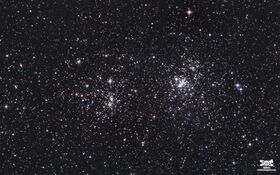Astronomy:7 Persei
| Observation data Epoch J2000.0 Equinox (celestial coordinates) | |
|---|---|
| Constellation | Perseus |
| Right ascension | 02h 18m 04.58449s[1] |
| Declination | +57° 30′ 58.7579″[1] |
| Apparent magnitude (V) | 5.99[2] |
| Characteristics | |
| Evolutionary stage | horizontal branch[3] |
| Spectral type | G7 III[4] |
| B−V color index | 1.039±0.007[2] |
| Astrometry | |
| Radial velocity (Rv) | −12.5±0.3[2] km/s |
| Proper motion (μ) | RA: −13.359[1] mas/yr Dec.: −1.240[1] mas/yr |
| Parallax (π) | 4.2163 ± 0.0437[1] mas |
| Distance | 774 ± 8 ly (237 ± 2 pc) |
| Absolute magnitude (MV) | −1.22[5] |
| Details | |
| Mass | 3.84[6] M☉ |
| Radius | 24[3] R☉ |
| Luminosity | 316[5] L☉ |
| Surface gravity (log g) | 2.44[6] cgs |
| Temperature | 4,974[6] K |
| Metallicity [Fe/H] | −0.11[6] dex |
| Rotational velocity (v sin i) | 11.5[7] km/s |
| Age | 191[5] Myr |
| Other designations | |
| Database references | |
| SIMBAD | data |
7 Persei is a star in the constellation Perseus, located 774 light years away from the Sun.[1] While the star bears the Bayer designation Chi Persei, it is not to be confused with the entire cluster NGC 884, commonly referred to as Chi Persei. It is faintly visible to the naked eye as a dim, yellow-hued star with an apparent visual magnitude of 5.99.[2] This object is moving closer to the Earth with a heliocentric radial velocity of −12.5 km/s.[2]
This is an evolved giant star with a stellar classification of G7 III,[4] most likely (93% chance) on the horizontal branch.[3] At the age of 191 million years,[5] it has 3.84[6] times the mass of the Sun but has expanded to 24[3] times the Sun's radius. The star is radiating 316[5] times the Sun's luminosity from its enlarged photosphere at an effective temperature of 4,974 K.[6]
References
- ↑ 1.0 1.1 1.2 1.3 1.4 1.5 Brown, A. G. A. (August 2018). "Gaia Data Release 2: Summary of the contents and survey properties". Astronomy & Astrophysics 616: A1. doi:10.1051/0004-6361/201833051. Bibcode: 2018A&A...616A...1G. Gaia DR2 record for this source at VizieR.
- ↑ 2.0 2.1 2.2 2.3 2.4 Anderson, E.; Francis, Ch. (2012), "XHIP: An extended hipparcos compilation", Astronomy Letters 38 (5): 331, doi:10.1134/S1063773712050015, Bibcode: 2012AstL...38..331A.
- ↑ 3.0 3.1 3.2 3.3 Stock, Stephan et al. (August 2018), "Precise radial velocities of giant stars. X. Bayesian stellar parameters and evolutionary stages for 372 giant stars from the Lick planet search", Astronomy & Astrophysics 616: 15, doi:10.1051/0004-6361/201833111, A33, Bibcode: 2018A&A...616A..33S.
- ↑ 4.0 4.1 Currie, Thayne et al. (2010), "The Stellar Population of h and χ Persei: Cluster Properties, Membership, and the Intrinsic Colors and Temperatures of Stars", The Astrophysical Journal Supplement 186 (2): 191–221, doi:10.1088/0067-0049/186/2/191, Bibcode: 2010ApJS..186..191C.
- ↑ 5.0 5.1 5.2 5.3 5.4 Takeda, Yoichi et al. (August 2008), "Stellar Parameters and Elemental Abundances of Late-G Giants", Publications of the Astronomical Society of Japan 60 (4): 781–802, doi:10.1093/pasj/60.4.781, Bibcode: 2008PASJ...60..781T.
- ↑ 6.0 6.1 6.2 6.3 6.4 6.5 Liu, Y. J. et al. (April 2014), "The Lithium Abundances of a Large Sample of Red Giants", The Astrophysical Journal 785 (2): 12, doi:10.1088/0004-637X/785/2/94, 94, Bibcode: 2014ApJ...785...94L.
- ↑ Rodrigues da Silva, R. et al. (March 2015), "On the Nature of Rapidly Rotating Single Evolved Stars", The Astrophysical Journal 801 (1): 6, doi:10.1088/0004-637X/801/1/54, 54, Bibcode: 2015ApJ...801...54R
- ↑ "chi Per". SIMBAD. Centre de données astronomiques de Strasbourg. http://simbad.u-strasbg.fr/simbad/sim-basic?Ident=chi+Per.
 |

